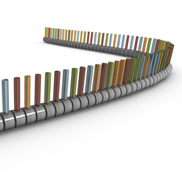
phosphate backbone

The sugar-phosphate backbone forms the structural framework of nucleic acids, including DNA and RNA. This backbone is composed of alternating sugar and phosphate groups, and defines directionality of the molecule.
DNA and RNA are composed of nucleotides that are linked to one another in a chain by chemical bonds, called ester bonds, between the sugar base of one nucleotide and the phosphate group of the adjacent nucleotide. The sugar is the 3' end, and the phosphate is the 5' end of each nucleiotide. The phosphate group attached to the 5' carbon of the sugar on one nucleotide forms an ester bond with the free hydroxyl on the 3' carbon of the next nucleotide. These bonds are called phosphodiester bonds, and the sugar-phosphate backbone is described as extending, or growing, in the 5' to 3' direction when the molecule is synthesized.
In double-stranded DNA, the molecular double-helix shape is formed by two linear sugar-phosphate backbones that run opposite each other and twist together in a helical shape. The sugar-phosphate backbone is negatively charged and hydrophilic, which allows the DNA backbone to form bonds with water.
Further Exploration
Concept Links for further exploration
















